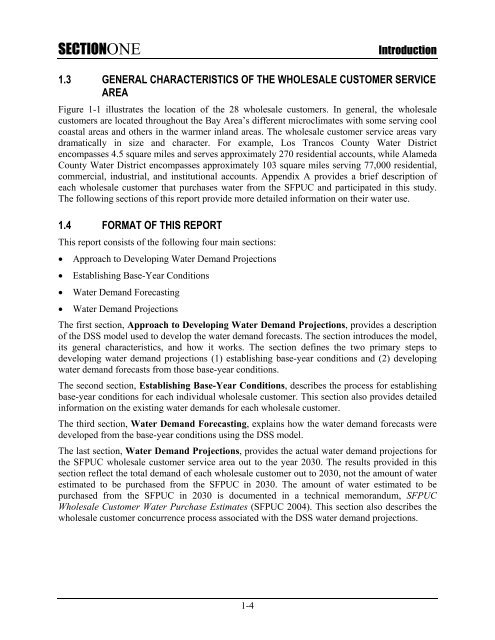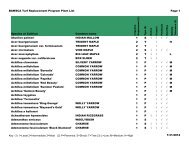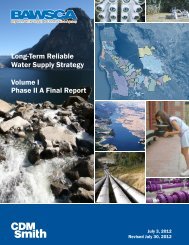SFPUC Wholesale Customer Water Demand Projections ... - BAWSCA
SFPUC Wholesale Customer Water Demand Projections ... - BAWSCA
SFPUC Wholesale Customer Water Demand Projections ... - BAWSCA
Create successful ePaper yourself
Turn your PDF publications into a flip-book with our unique Google optimized e-Paper software.
SECTIONONE<br />
Introduction<br />
1.3 GENERAL CHARACTERISTICS OF THE WHOLESALE CUSTOMER SERVICE<br />
AREA<br />
Figure 1-1 illustrates the location of the 28 wholesale customers. In general, the wholesale<br />
customers are located throughout the Bay Area’s different microclimates with some serving cool<br />
coastal areas and others in the warmer inland areas. The wholesale customer service areas vary<br />
dramatically in size and character. For example, Los Trancos County <strong>Water</strong> District<br />
encompasses 4.5 square miles and serves approximately 270 residential accounts, while Alameda<br />
County <strong>Water</strong> District encompasses approximately 103 square miles serving 77,000 residential,<br />
commercial, industrial, and institutional accounts. Appendix A provides a brief description of<br />
each wholesale customer that purchases water from the <strong>SFPUC</strong> and participated in this study.<br />
The following sections of this report provide more detailed information on their water use.<br />
1.4 FORMAT OF THIS REPORT<br />
This report consists of the following four main sections:<br />
• Approach to Developing <strong>Water</strong> <strong>Demand</strong> <strong>Projections</strong><br />
• Establishing Base-Year Conditions<br />
• <strong>Water</strong> <strong>Demand</strong> Forecasting<br />
• <strong>Water</strong> <strong>Demand</strong> <strong>Projections</strong><br />
The first section, Approach to Developing <strong>Water</strong> <strong>Demand</strong> <strong>Projections</strong>, provides a description<br />
of the DSS model used to develop the water demand forecasts. The section introduces the model,<br />
its general characteristics, and how it works. The section defines the two primary steps to<br />
developing water demand projections (1) establishing base-year conditions and (2) developing<br />
water demand forecasts from those base-year conditions.<br />
The second section, Establishing Base-Year Conditions, describes the process for establishing<br />
base-year conditions for each individual wholesale customer. This section also provides detailed<br />
information on the existing water demands for each wholesale customer.<br />
The third section, <strong>Water</strong> <strong>Demand</strong> Forecasting, explains how the water demand forecasts were<br />
developed from the base-year conditions using the DSS model.<br />
The last section, <strong>Water</strong> <strong>Demand</strong> <strong>Projections</strong>, provides the actual water demand projections for<br />
the <strong>SFPUC</strong> wholesale customer service area out to the year 2030. The results provided in this<br />
section reflect the total demand of each wholesale customer out to 2030, not the amount of water<br />
estimated to be purchased from the <strong>SFPUC</strong> in 2030. The amount of water estimated to be<br />
purchased from the <strong>SFPUC</strong> in 2030 is documented in a technical memorandum, <strong>SFPUC</strong><br />
<strong>Wholesale</strong> <strong>Customer</strong> <strong>Water</strong> Purchase Estimates (<strong>SFPUC</strong> 2004). This section also describes the<br />
wholesale customer concurrence process associated with the DSS water demand projections.<br />
1-4







